Ebike Industry Updates
Some links may be affiliate links. We may get paid if you buy something or take an action after clicking one of these.
Their product line received an exciting addition earlier this month when they announced their new cargo e-bike, the CX.
V9 of the Goccycle app is just the first step in a process that the company says will result in new features being deployed to owner’s smartphones. The upgrade to V9 is substantial enough that the company says it will be unable to support the old version of the app and that Goccycle owners will need to upgrade to V9.
Sponsor
Sponsor

Some links may be affiliate links. We may get paid if you buy something or take an action after clicking one of these.
Stromer’s parent company, myStromer AG, which is also the parent of e-bike brand Desiknio, accomplished a major feat in 2023 by growing their market share in two of Europe’s hottest e-bike markets, Belgium and the Netherlands. The company managed an even more unlikely deed in the U.S. by charting double-digit growth.
Among Stromer’s accomplishments in 2023, they built the first rideable prototype e-bike using a ceramic battery. They also forged a multi-year relationship with Alinghi Red Bull Racing to introduce two Alinghi Red Bull Racing Special Edition Stromer models.
Sponsor
Sponsor

Considering that travel-focused companies like Thule make bicycle carriers, it’s obvious that flying with a bike is a thing. But what about flying with an e-bike? When checking luggage, airline agents ask about lithium ion batteries and TSA asks about them as well when we move through security.
Policies on flying with a bike vary from airline to airline. Most consider a bike in a carrier to be oversize, which results in a charge that can run from as little as $35 up to more than $200, per leg.
While the charges for bikes can seem arbitrary and maybe even capricious, flying with an e-bike is a different matter entirely. Because e-bikes use lithium-ion batteries, the transportation of those batteries is governed by the Federal Aviation Administration (FAA).
The FAA has placed strict limits on the size of lithium-ion batteries permitted on planes, both in carry-on and checked luggage.
The maximum permissible size for a lithium-ion battery is 100Wh. The specific language can be found in the Code for Federal Regulations under § 173.185 (1,i).

The LMT’D V2 arrived as a Class 2 e-bike with throttle and pedal assist up to 20 mph, though it can be switched to a Class 3 through its settings menu. This grants access to pedal assisted speeds up to 28 mph (the throttle remains limited to 20 mph). As such, I performed a Speed Test in both its Class 2 and Class 3 modes to measure its maximum speeds in its 5 PAS settings. The data from both tests is graphed above.
Our test course is a flat section of paved bike path with straights and curves. Due to the LMT’D’s use of a torque sensor for motor engagement, I maintained a consistent, casual-to-moderate level of effort so as to observe the differences between settings.
In Class 2 mode, I began the test by pedaling with the PAS deactivated (PAS 0) and reached 10.6 mph comfortably. My speeds increased relatively steadily to 13.5 mph in PAS 1, 15.8 mph in PAS 2, 19.1 mph in PAS 3, and 21.0 mph in PAS 4. With the bike limited in its Class 2 settings, there was no room left to go above my PAS 4 speed; I measured the same maximum in PAS 5.
In Class 3 mode, there was an immediate and noticeable difference in the motor’s output across the full span of assist levels. I once again noted steady increases of speed, with maximum results of 14.8 mph in PAS 1, 18.9 mph in PAS 2, 22.8 mph in PAS 3 and 25.1 mph in PAS 4. Finally, I felt a significant kick upon selecting PAS 5; the bike rocketed to 29.9 mph with its maximum output.
With a 48V, 750W rear-hub motor, the bike’s ability to reach the Class 3 limit in PAS 5 (with some gusto, I might add) was no surprise; this is a powerful motor that is able to draw and use current from the battery quickly. However, I found that the bike’s ride felt much more reserved than I expected in its lower PAS settings than I expected based on its specs. I thoroughly appreciated the bike’s non-electric feel, so this was a pleasant surprise!

Some links may be affiliate links. We may get paid if you buy something or take an action after clicking one of these.
The two e-bikes, the S1 and the C1 are intended to be lighter than typical e-bikes. Navee says they will weigh between 25 and 30kg (55 to 66 lbs.), in order to make them easier for smaller riders or riders with limited strength or mobility to manage.
The two e-bikes share many design features. Both feature step-thru frame designs. They can be ordered with either 250W or 350W motors (500W or 700W max output, respectively) and several different batteries, from 468Wh up to 612Wh. Both e-bikes come with 26-in. wheels and front and rear drum brakes. Navee included both a torque sensor and a cadence sensor to make them as responsive as possible.
Both e-bikes are projected to have a range of up to 75km (46.6 mi.) per charge, and will be speed limited to 25kph (15.5 mph).
Sponsor

Some links may be affiliate links. We may get paid if you buy something or take an action after clicking one of these.
Due to concern for the rising rates of lithium-ion battery fires which are often incorrectly attributed to e-bikes, Denver will require that anyone using one of their vouchers to purchase an e-bike that complies either with UL 2271 (batteries) or UL 2849 (the entire system including motor and battery).
The vouchers will be released in five batches. The first batch was released Tuesday, February 27. Additional batches will be released April 30, June 25, August 27 and October 29. Vouchers are good for 90 days.
The program is aimed at low-income Denver residents; vouchers are awarded to households that earn less than 60 percent of Colorado’s median income ($86,900 for individual earners or $99,300 for two earners), less than 60 percent of the area median income or less than 200 percent of the federal poverty level.
Sponsor

Motor and battery
One of the standout features of the Himiway A7 Pro is its 500W mid-drive motor. Most mid-drives we see produce 250W and less than 100Nm of torque. This 500W motor produces a whopping 130Nm of torque. Combine that with the torque sensor and what the rider gets is an e-bike that is immediately responsive to pedal input and enough torque to make this ride accelerate like a muscle car.
The 720Wh battery features Samsung and LG cells for excellent reliability. Himiway suggests that riders may see as much as 50 mi. of range per charge, which would seem modest if not for the fact that this is a 500W mid-drive motor; 50 mi. would be reasonable for such a powerful mid-drive motor.
The Himiway A7 Pro ships as a Class 2 e-bike with a top assist speed of 20 mph, whether pedaling or on the throttle, but it can be unlocked for a maximum pedal-assist speed of 28 mph.
Componentry
One component on this e-bike that’s easy to miss is the dropper seatpost. Seatposts are rarely interesting on commuter e-bikes, but this one features a small lever just below the nose of the saddle. Pull it up, put your weight on it and you can slide it down to your preferred height. Release your weight, and it will rise when you pull the lever.
With a commuter, you rarely need to change saddle height once you’ve set it for your needs, so why include a dropper post? This is for the family that has more than one user for this e-bike. In a household with two or more fully grown people, buying everyone an e-bike might not be feasible, so purchasing one that everyone can use with ease would make terrific sense.
Some links may be affiliate links. We may get paid if you buy something or take an action after clicking one of these.
Orbic is an electronics manufacturer that makes smartphones, laptops, tablets and wearables, and now e-bikes.
The Orbic 5G e-bike is equipped with a forward-facing and rear-racing cameras. The 2MP rear-facing camera has a 140-degree view and its feed is both recorded and sent to an AI-powered object detection system that will alert riders with both audio and visual signals to increase their safety. The 64MP front-facing camera’s feed is recorded so riders can play back their adventures after the fact.
Sponsor
Sponsor

Some links may be affiliate links. We may get paid if you buy something or take an action after clicking one of these.
The government is forming a consultancy of which the Department of Transportation will be a member. Reports indicate that e-bike makers will be solicited for input as well. In addition to the current 250W limit, e-bikes in the U.K. does not permit e-bikes to be equipped with throttles. New legislation could potentially see wattage doubled and throttles normalized.
In a move that may seem surprising, the Bicycle Association, a U.K. e-bike trade group made up of suppliers and retailers, has previously lobbied against increasing the power in e-bikes. Their concern stemmed from a fear that more powerful e-bikes would result in the government reclassifying them as something other than bicycles. A change in the classification of e-bikes could see them required to be registered, carry insurance and banned from bike paths and the bike industry is concerned that reclassification could hurt further adoption of e-bikes.
So while the bike industry worries that more powerful e-bikes could result in new legal constraints that could hurt e-bike sales, the government worries that a 15.5 mph maximum assist speed may be an underwhelming speed to drivers who might be more interested in e-bikes … if only they went faster.
Notably absent from the current proposals is any reconsideration of that 15.5 mph maximum assist speed, though. Practically speaking, moving from a 250W nominal limit to 500W would result in e-bikes that simply accelerate more quickly. It would likely also result in an increased presence of e-bikes with hub motors. An e-bike with a 250W mid-drive motor is plenty powerful, but a 250W hub motor is decidedly underpowered. A jump to a maximum nominal rating of 500W would make hub motors more practical and could aid adoption of e-bikes by bringing more affordable e-bikes to the market in the U.K.

Some links may be affiliate links. We may get paid if you buy something or take an action after clicking one of these.
Thanks to a bench-style seat and both front and rear suspension, this will give riders a smooth ride even on rough roads. We will explain why in our Himiway C5 review.
Providing the muscle for the Himiway C5 is a 750W brushless, geared hub motor, which is powered by a whopping 960Wh battery. Considering most riders are likely to spend their time using the throttle instead of the pedals, that was a terrific choice.
Let’s have a look at the Himiway C5’s other details.
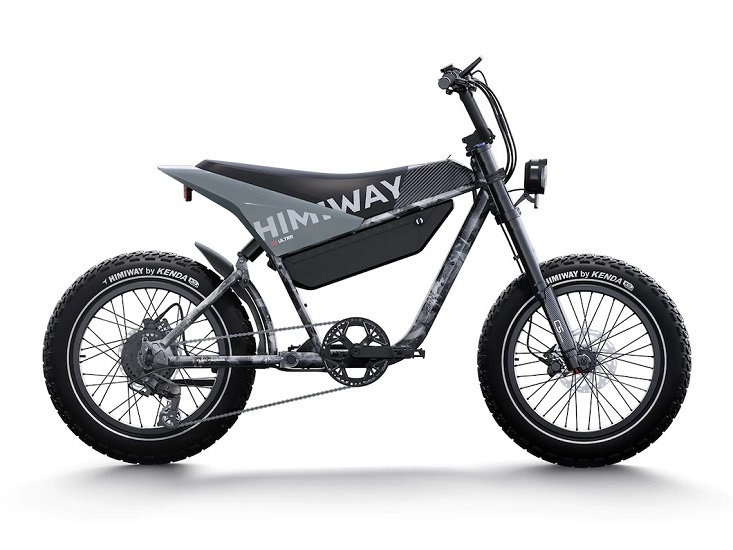
Some links may be affiliate links. We may get paid if you buy something or take an action after clicking one of these.
From 2017 to 2022, the number of fires caused by e-mobility devices in San Francisco rose each year, culminating in a high for the city of 58 fires in 2022. During that time period, the city has seen eight injuries and one fatality caused by those fires.
Beginning in March, new rules will go into effect that will specify how e-mobility devices can be charged in multi-unit housing.
Multi-unit buildings will now be limited to a maximum of four lithium-ion-battery-powered e-mobility devices per household. Additionally, there must be at least three feet between each device when they are charging. Also, each charger must be plugged into its own outlet, not a power strip.
Sponsor

The combined forces of the Pinion and Gates components have a number of benefits. First, the gearbox itself uses Pinion’s Smart.Shift technology; this electronic shifting system allows for fast (0.2 seconds) gear changes at the push of a button while moving, stationary, and under load.
The system can also shift automatically based on the rider’s cadence. Once set through the Pinion Smart.Shift app, the gearbox will downshift when going uphill or upon stopping, upshift when moving downhill, and also adjust when coasting. Our phone had some trouble connecting to the system (likely an Apple problem instead of a Pinion problem) to test the automatic shifting features, but the manual shifting was slick, quick, and quiet.
Additionally, the system’s design is incredibly low-maintenance. The enclosed nature of the gearbox protects all of the gearing from impact damage and intrusion from dirt or water. With no chain or cassette, there is less overall wear, and fewer parts that require replacement. Pinion recommends that the internal oil bath be changed annually or every 6,200 miles, and they expect the gearbox itself to last for more than 60,000 miles.
Finally, the Carbon Belt connecting the motor to the gearbox requires no lubrication, and can last up to twice as long as a chain. Owners can use the Gates Carbon Drive app to sonically check for proper belt tension. Considering that, unlike a chain, the belt does not stretch with use, we expect the need for adjustments to be infrequent.
Power in Spades: A Speedy, Sprightly Ride
Some links may be affiliate links. We may get paid if you buy something or take an action after clicking one of these.
The Frey Dopamine 2.0 offers riders hoping to knock out long rides as quickly as possible a novel option. With a 500W mid-drive motor from Bafang, the Frey Dopamine 2.0 has the muscle necessary to go a full 28 mph. This Class 3 eMTB (28 mph maximum assist speed plus a throttle) is powered by a 720Wh battery.
One novel feature of the Frey Dopamine 2.0 is its ability to run several different wheel setups, depending on the size of frame the rider needs. It comes in three sizes: medium, large and XL. Frey says that the Dopamine 2.0 can be run with 29-in. wheels front and rear, or 27.5-in. wheels front and rear or as a mullet setup with 29 front and 27.5 rear. The medium can be set up with a 27.5 wheel in front and a 26-in. wheel in the rear to serve as a small size.
Wheel size affects the suspension options; with 29-in. wheels or configured as a mullet, it has 160mm of travel front and rear, while with 27.5-in. wheels it sports 180mm front and 170mm rear. If there was any doubt about how aggressive a rider for whom Frey made Dopamine 2.0, the 63.5-degree head tube angle is half a degree (or more) slacker than what we see in many eMTBs.
Sponsor
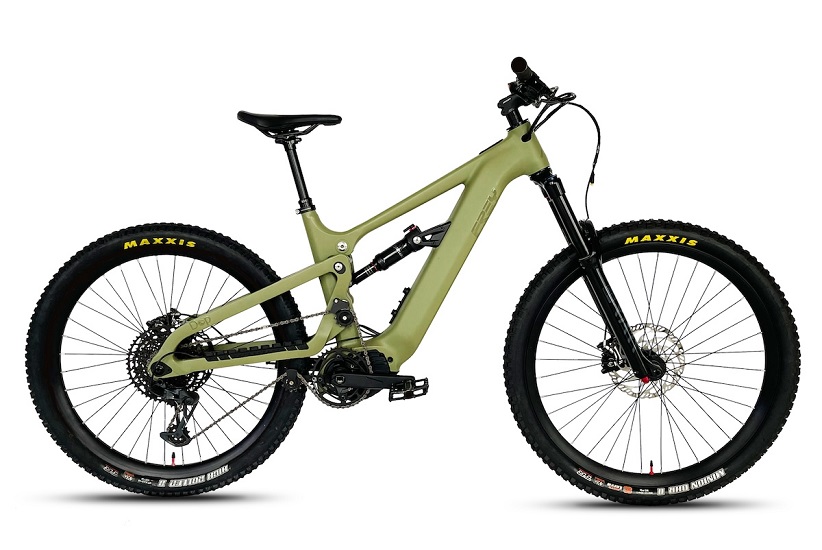
During my testing of this bike, I found myself really enjoying the overall ride. There is an adjustable stem, handlebar and seat post height that really allow the rider to find a fit that works best for them, adding to its overall ride quality. The cruiser design of the bike offers riders an upright body position with a good field of view of the road in front of them.
Now, the folks at ADO say this bike will support riders from 5’ 3” to 6’ 11”. That’s a very large range, and while I’d love to put that to the test, we don’t have anyone near 6’ 11”. But, we do have someone who is 6’ 5” and they took the ADO Air 28 for a spin and found it to work well for them after moving up the seat a bit. So, take that for what it’s worth.
Commuters will appreciate perks like a front headlight, rear rack and pannier bag attachment bars.
Down below, the puncture-resistant Chaoyang 26×1.95” tires with a semi-slick tread pattern felt very smooth on the road with no noticeable road noise. Additionally, I spent a few hours riding on wet roads and the tires never budged on grip giving me a safe ride, even when cornering.
Speaking of wet roads, the ADO Air 28 has both front and rear color matched metal fenders that did an excellent job protecting me from rain and puddles splashes along my route.
Some links may be affiliate links. We may get paid if you buy something or take an action after clicking one of these.
This new Class 3 carbon fiber gravel bike can handle adventures from a day to all-weekend.
As a gravel e-bike, the Grizl:ON looks like a road e-bike, just with big tires. It has the drop bar and forward-slung rider position of a road e-bike and comes in five sizes (XS through XL). Where it differs is in handling, tire width, drivetrain and suspension.
The Grizl:ON is built with a lightweight carbon fiber frame and Bosch Performance Line SX mid-drive motor, which provides 250W of power and 55Nm of torque. The 400Wh battery will provide hours of riding.
Gravel e-bikes tend to have calmer handling that road e-bikes so that they ease into turns more and are more likely to track straight if the riding surface is soft. And where a road e-bike might have a tire that’s 1-1.25 in. wide, the Grizl:ON has a tire that’s 1.8 in. wide, which will offer a more comfortable ride and better traction on unpaved surfaces. The drivetrain also features a wider gear range because the places that gravel e-bikes go often feature hills steeper than are typically paved. And, where road e-bikes almost never have suspension, the Canyon Grizl:ON comes with a RockShox Rudy suspension fork with 40mm of travel—enough to take the sting out of the roughest roads.
Most of the parts come from Shimano’s GRX group, which is made specifically for gravel e-bikes. It’s durable and precise stuff, reliable in a way you need if you’re 50 mi. from home and in the woods. In a move that’s unusual for gravel and road e-bikes alike, Canyon worked with Lupine to include lights integrated into the front and rear of the Grizl:ON.

Bebopping with Rocksteady: This Huge and Heavy Commuter Boasts Heaps of Power and Long Range Potential
Here at Electric Bike Report, we often hear prospective and current e-bike owners wishing for the ability to cover more miles on a single charge. With the D5 Ultra, Himiway responded to these appeals by including TWO 48V, 720 watt-hour (Wh) batteries. This adds to the bike’s overall size and weight, but with a total of 1440 Wh of capacity, also greatly extends its range; we were extremely satisfied with the bike’s performance in our Range Test.
The Rhino’s size was perhaps its most immediately obvious feature, including its massive 26”x4.5” tires. It felt like a tank – and it weighed a jaw-dropping 104 lbs! The upside of the D5 Ultra’s size, weight, and super-wide tires was that it felt remarkably stable and solid while riding.
We also enjoyed a high degree of visibility from the bike’s high riding position. Its wide, cushy saddle and ergonomic rubber grips added to the overall comfort. We found its riding position and comfort level to be appropriate for the long-distance rides its dual batteries are capable of.
For all the D5 Ultra did right, it had a few areas with room for improvement. For example, the entry-level brakes performed fine, but such a large bike would benefit from an upgraded brake set. Additionally, the 1,000W mid-drive motor could be punchy, but accessing its full power wasn’t as easy as we expected. We’ll explore the details later in this Himiway D5 Ultra review; continue reading below for the results of our Speed, Range, Hill, and Brake Tests!
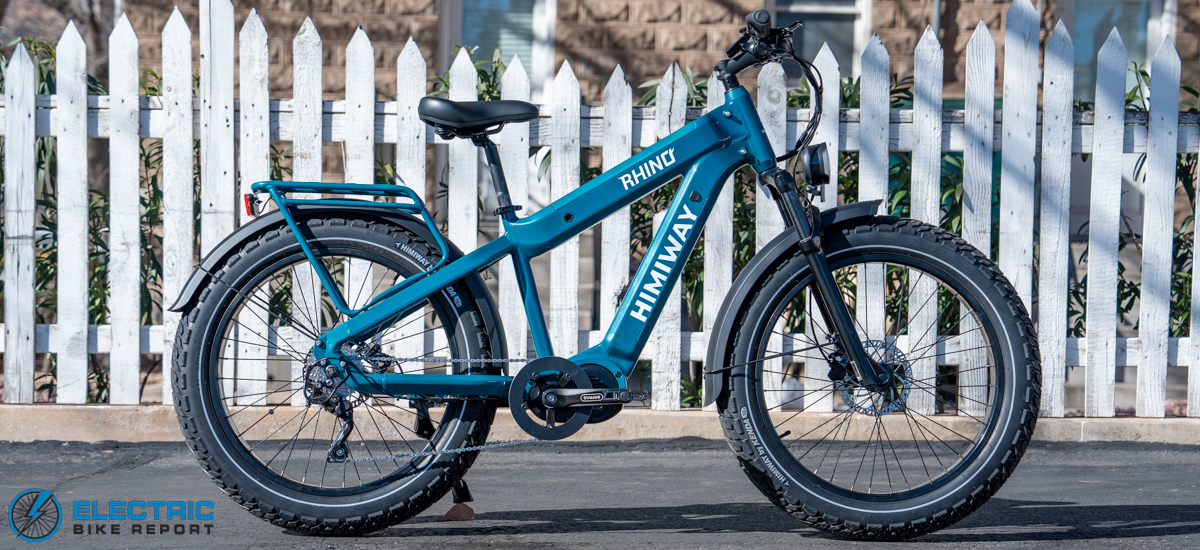
Some links may be affiliate links. We may get paid if you buy something or take an action after clicking one of these.
The station is public more in concept than function. Its use will be limited to 100 e-bike delivery workers and they will be able to charge batteries at no cost to them.
Poorly made and illegally repaired lithium-ion batteries were responsible fires that injured 150 people and killed 18 in 2023 alone.
The charging station is located in Cooper Square in the East Village. In the coming weeks, New York officials plan to open four additional stations in Brooklyn and Manhattan.
Sponsor

Some links may be affiliate links. We may get paid if you buy something or take an action after clicking one of these.
QuietKat introduces an all-wheel-drive model for the ultimate in off-road muscle.
All-wheel-drive e-bikes have intrigued riders ever since the first hub motors were devised. Traditionally, though, all-wheel-drive designs have suffered from what is called “front wheel tug.” This is a phenomenon where the front and rear wheels don’t feel like they are cooperating in a turn. The QuietKat Ranger AWD solves this with a unique controller that they say improves both traction and power and, ultimately, fun.
Riders can toggle between traditional rear-wheel drive, front-wheel drive and all-wheel drive. Peak power output can hit 2000W, making it one of the most powerful e-bikes on the market.
The QuietKat Ranger AWD begins with 750W brushless, geared hub motors front and rear, powered by an 828Wh battery which QuietKat estimates will offer riders a range of up to 52 mi.
The 6000-series aluminum frame comes in two sizes (medium and large) and features an integrated rear rack and is paired with a 120mm suspension fork. The drivetrain offers but one gear, presumably because with so much power on tap it won’t need any help from the rider getting up to speed or climbing hills.
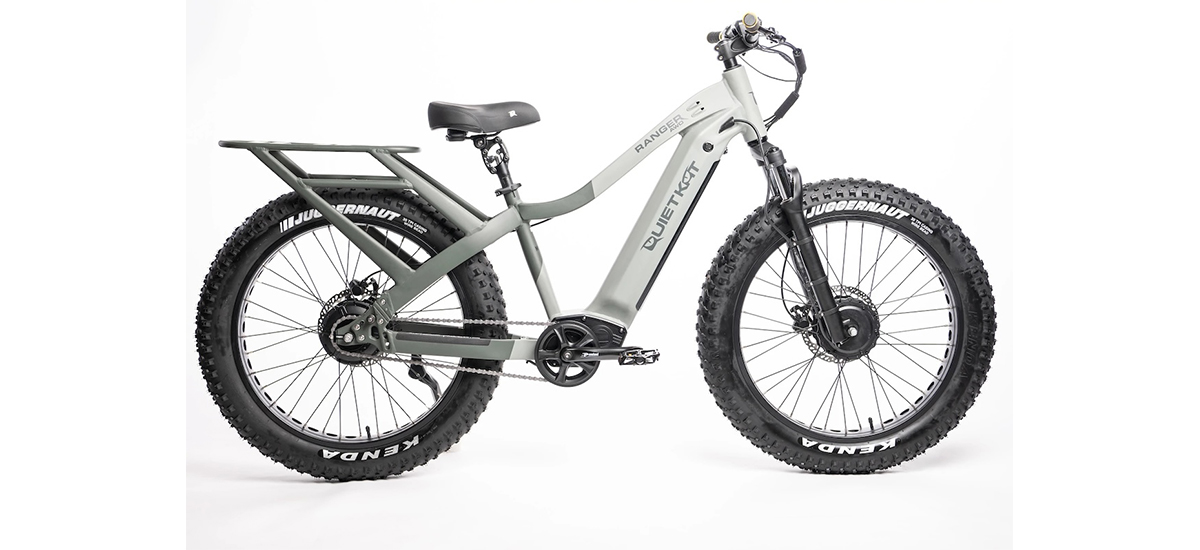
Some links may be affiliate links. We may get paid if you buy something or take an action after clicking one of these.
Dutch brand is bringing its first pedelec to the US.
Previouslywe liked their Medeo T9 City when we reviewed it.
The Bosch Smart System is an integrated suite of products that includes the Bosch motor, battery, display and controller as well as their eFlow app.
Smart System changes what the rider sees on the Kiox display based on how they are riding. When climbing, the display shows cadence, power and elevation, but when descending, it switches to focus on speed. When stopped, the Kiox switches to show summary information such as maximum speed, distance ridden and, importantly, remaining range.
The Gazelle Eclipse is made in both a high-step and a low-step frame. Both editions of the Eclipse retail in the $5000-$6000 range. Both versions include a Bosch Active Line motor that produces 85Nm of torque, a 750Wh Bosch battery, 4-piston Shimano hydraulic disc brakes, 60mm-wide (2.2 in.) tires and an MIK rear rack.
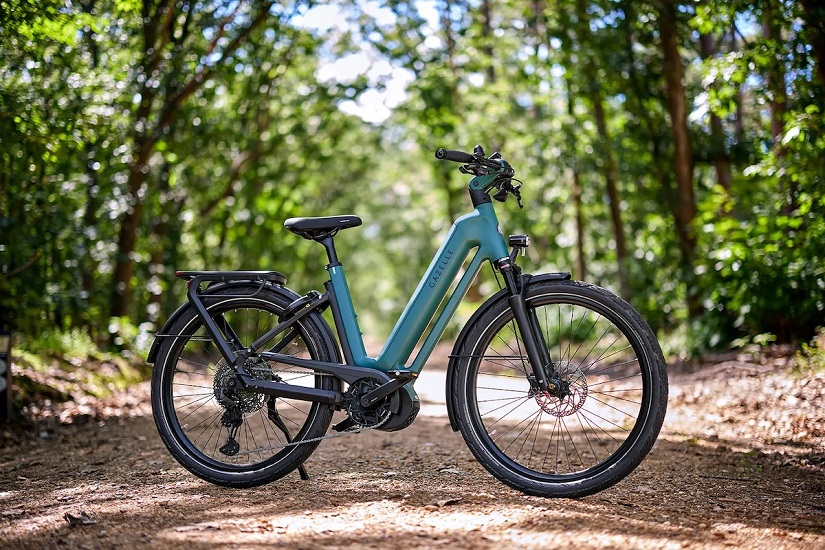
To demonstrate product safety there are a variety of different standards and certifications that judge just how safe an e-bike is. Most Americans are familiar with the logo of Underwriters Laboratories. UL, as they are known, is arguably the largest and best-known safety and certification organization globally.
What are certification standards?
Safety standards are meant to ensure a product will meet certain expectations for safe operation in a variety of circumstances. UL was the first body to establish safety standards, and they began with the tin-clad fire door, effectively the first fire door, way back in 1903. Today, their standards are used in 125 countries world-wide.
Certification standards are generally meant to address what happens in sub-optimal conditions. Most products work fine under normal circumstances. But what happens if you leave the product in the car on a summer day and the temperature reaches 140 degrees inside? Addressing all of the less-than-ideal conditions a product may be subjected to is the point of a safety standard.
UL, however, is not the only organization that writes safety standards. E-bikes sold in multiple markets, such as the US and Europe, must meet a variety of similar—though not identical—standards published by multiple agencies.


